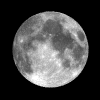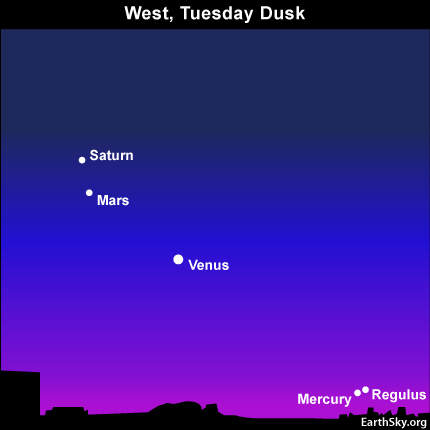Courtesy of EarthSky
A Clear Voice for Science
www.EarthSky.org

 The planets Saturn, Mars and Venus are still in the west after sunset, to the delight of stargazers across the globe. In addition, the planet Mercury –our solar system’s innermost world – teams up with Regulus around now in the same part of the sky. Regulus is the brightest star in the constellation Leo the Lion. Tonight, Mercury and Regulus form the year’s closest pairing of a planet with a first-magnitude star. Look for them very low in the west, very shortly after sunset!
The planets Saturn, Mars and Venus are still in the west after sunset, to the delight of stargazers across the globe. In addition, the planet Mercury –our solar system’s innermost world – teams up with Regulus around now in the same part of the sky. Regulus is the brightest star in the constellation Leo the Lion. Tonight, Mercury and Regulus form the year’s closest pairing of a planet with a first-magnitude star. Look for them very low in the west, very shortly after sunset!
EarthSky’s meteor shower guide for 2010
Our chart shows the sky for about 45 minutes after sunset (at mid-northern latitudes). The planetary line-up from top to bottom features Saturn, Mars, Venus and Mercury, and slants low across the western sky. At latitudes nearer the equator and in the southern hemisphere, the planets stand more vertically to the western horizon.
For this reason, the Mercury/Regulus attraction favors the southern hemisphere. At mid-northern latitudes – like those in the US – Mercury and Regulus set an hour or so after the sun. We will need an unobstructed horizon, crystal-clear skies and possibly binoculars to spot the pair in the twilight glare.
South of the equator – like in Australia – Mercury and Regulus set some 2 hours after sunset, providing southern hemisphere viewers with a dark sky and a ringside seat to this year’s closest pairing of a planet and a first-magnitude star!
From either hemisphere, draw a line from ruddy Mars through Venus – the sky’s brightest planet – to locate Mercury and Regulus near the horizon.
Written by Bruce McClure
Astronomy Picture of the Day from NASA/JPL
U.S. Naval Observator Astronomical Information center
The York County Astronomical Society
 Print This Post
Print This Post








